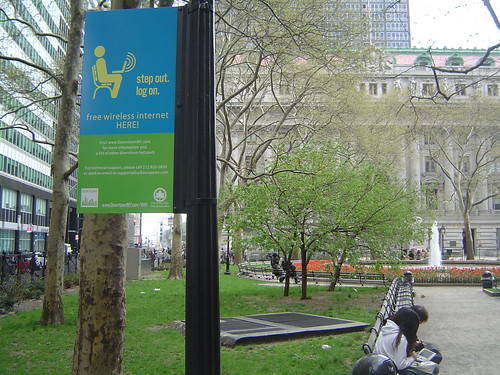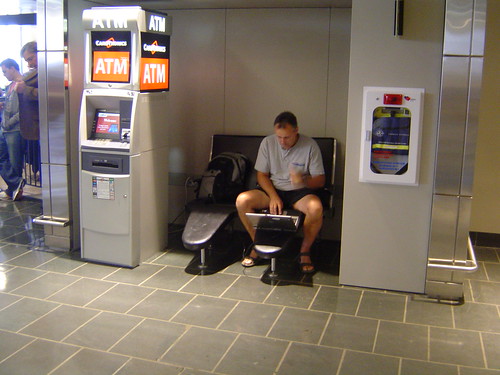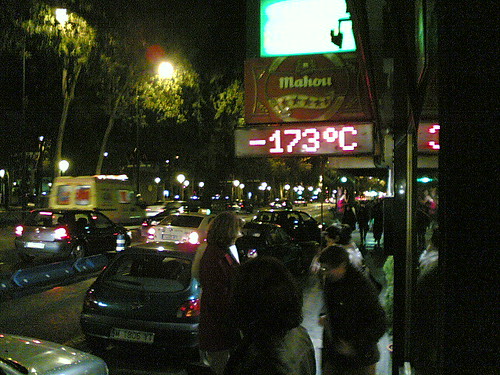The End of Timelessness
Posted: April 11th, 2009 | No Comments »Writing the conclusion of my dissertation, there is one implication of my research work that I still have not completely gotten my brain around. I will try to layout my thoughts here. I believe that one contribution of my work has been to reveal the new aspects of time with our relation to space through ubiquitous technologies. For instance, I have studied the co-evolution of a community of early adopters with their navigation system, the timely capture of travelers experiences, the potentials of spatio-temporal data shadows such as measuring the evolution of the attractiveness of the space. Each study shows that our relation with geoinformation (and by extension space) has been altered from our interactions with mobile and wireless technologies. The information is accessible and generated ubiquitously, augmenting our roles of sensors and actors of the space. This presence of what Adam Greenfield would refer to, in a more articulate manner, as the Big Now creates an utilitarian fascination to the real-time or the predictability as instantiated in my case study on “Detecting air travel in real time” from a mobile phone implicit interaction wireless networks (in submission). This fascination overshadows the end of our ephemeral relation with space potentially leading to a new version of the Internet Archive’s Wayback Machine and the presence of the hard/soft infrastructure design that does not take it into account.
I call it the end of timelessness. The end of the ephemeral, or what Adam Greenfield would describe as the Long Here, is mainly exposed in my work on Tracing the Visitor’s Eye and related. The observations of the presence of the hard infrastructures that deny the Long Here took place around the NYC Waterfalls study and the novel opportunity to define of indicators of the evolution of attractiveness of the space. Similarly, the ubiquitous technologies of the present, fail to accommodate for the Long Here, the change in the city and the implication on the social practices. Wearing qualitative lenses with a taxi drivers in Barcelona, I could observe co-evolutive ballet with their navigation system and extract the implications of the soft infrastructure on the knowledge of the city.
The embedment of urban informatics into the urban fabrics makes the integration of the Long Here in integral part of the design of hard and soft infrastructures. I would argue that this kind of case studies sets stage to the end of the timelessness considerations of individuals interactions with urban infrastructures. A satellite navigation system does not perform the same service the first six months in the practices of a inexperienced taxi drivers compared to a user with 20 year of knowledge of the city. Moreover, they do not, over time, request the same granularity of geoinformation nor do they assess the quality of the information with the same experience of the technology and knowledge of the city. A different kind of “long here” evolution of the presence and practices of that can be analyzed through their interactions with soft infrastructures to assess the quality of the spatial settings. This longitudinal understanding of the evolution of the interaction can then be applied to the design of the urban informatics. For instance, we made sure that our mobile phone algorithm to detect air travel was not perfect, as our system takes advantage of false detections to keep the survey participants with a certain level of involvement.
The evolution of the people practices, interactions and frictions with the urban space can be compiled very informally as Nicolas and I compiled in Sliding Friction and related. This kind of approach helps highlighting the reality, its complex dynamics, its subtleties, and its situational particularities. My research work suggests the combinations of more formal data collection and analysis approaches. They took the form of quantitative (reality mining), qualitative (ethno-inspired), mixed research methods to a more active, utility-driven mode with design science research.

New use of Bowling Green, the oldest public park in New York City
Now these approaches strongly contrast with the practice of architecture and urban design that almost utterly ignore this notion of time. For instance, from my understanding, there exist limited methods to capture and evaluate the user experience and the use of the built space. That makes me wonder wether since Stewart Brand’s How Buildings Learn (video of the BBC TV series inspired by the book) any progress has been made to integrate the complexifying intertwinement of hard infrastructures, soft infrastructures and individual/social practices into their design practices. 15 years ago, Frank Duffy explained that “architects have been slow to join the evaluation bandwagon, It’s got somewhat trapped in the academic field, I am afraid“. When considering the hybrid space with real-time elements, asynchronous communications and its logging capabilities of soft infrastrcture, it seems that the human/social elements with their evolution and adaptability find little consideration when in competition with aesthetic.

A bench to relax or work or both? between an ATM and a defibrillator at the cramped part of Logan airport
In consequence, as Steward Brand explains, “More often than not, the pull to conduct evaluations has come from client organizations, not from the architects themselves” also suggesting to collect feedback from facility manager to grasp the dimensions of time and use into building. In contrast, in the digital world, there is a greater tradition of analysing breadcrums to improve the design of web sites. Of course, nowadays, who and where are the facility managers in hybrid spaces?
The lack of consideration of the human in current practices of the designer of the hard infrastructures is particularly striking with the traditional aseptic graphics and medium to communicate them. But the competences to learn from the evolution of the infrastructure do not only require interpretative methods for human and social dynamics, but also for technological/intrastructural counterparts. For instance, 4 years ago, the analysis the players space-time trails in our pervasive game CatchBob! with a custom made “replay tool” necessitated technical knowledge to extract the technological issues of the ubiquitious infrastructures and its evolution. I would not expect this to be otherwise nowadays. This to exemplify that the ability to understand and properly bend the hard infrastructure will naturally come from cross-disciplinary teams that consider time in their practice. For instance, software engineering has been evolving in its practice to check the quality assurance throughout the life of a software (see Software that makes software better). The techniques aim at preventing from the software to break without running it (statistic analysis tools) and also detect when it breaks (dynamic analysis tools).

Consequence of unproper blackbox testing… Maybe an error caused by a 64 bit floating point number relating to the outdoor temperature respect to the wind conditions converted to a 16 bit signed integer
Relation to my thesis: Extract some contribution of my PhD thesis (the end of timelessness) to consider their implications on the evaluation of the evolution of the relation between the hard, the soft and the human in hybrid environments. From my experience, a mix of methods are necessary to grasp a world of fast-moving technology. This methods go beyond the current limited approaches of practitioners of the built space, to the exception of Post-occupency evaluations that introduce the dimensions of time and use into building. On the other hand, the practices of practitioners of the soft and digital world are evolving to take time and evolution into consideration. Of course that should lead to an improvement in: reliability, life-cycle behavior, environmental impact and user acceptance.
My research work sets the stage for tools and techniques to reveal evolution or repetitions, with observations and measures of expectation, initial frustration and delight, adjustment, and long-term adaptivity. I examply some elements in my taxi drivers study, the application of metrics as in new york and the collection of evidences “sliding frictions”.

